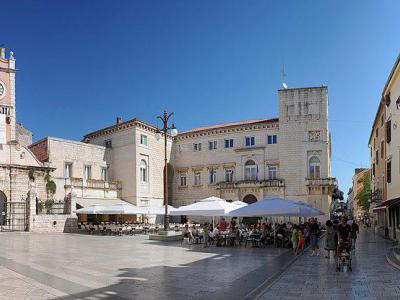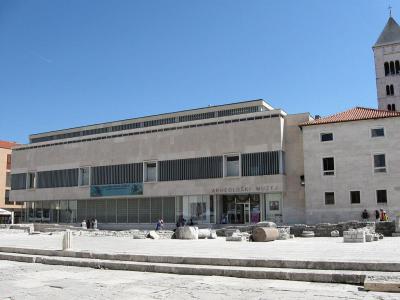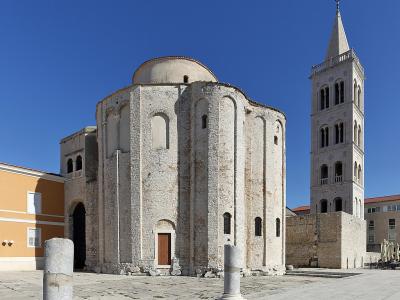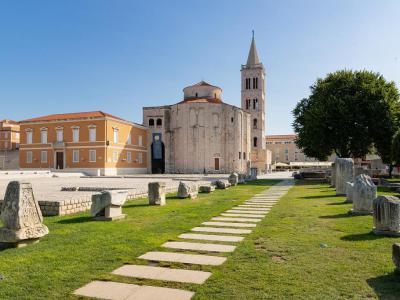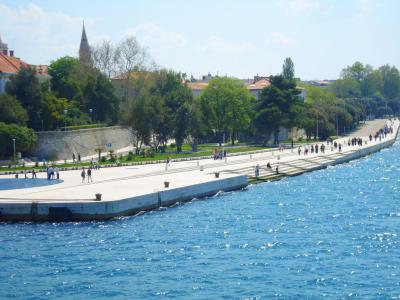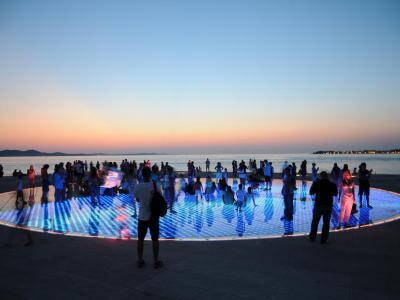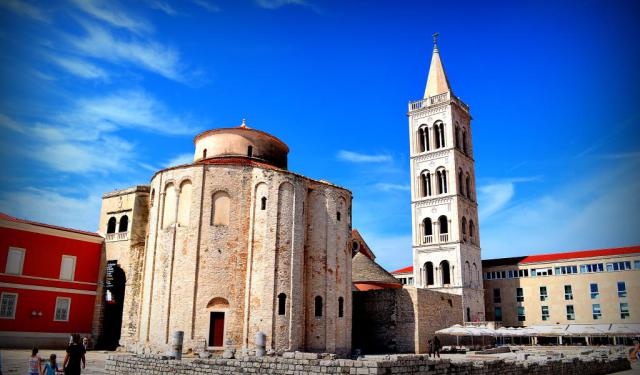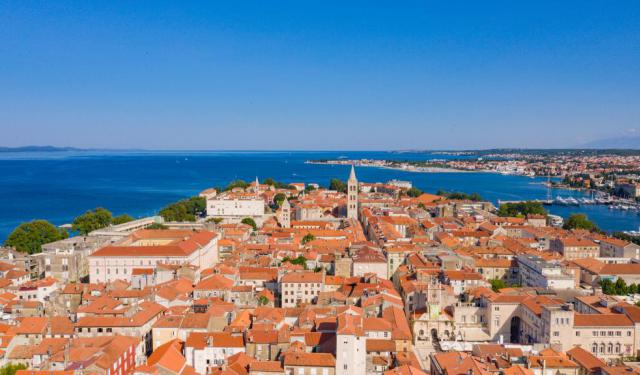
Zadar Introduction Walking Tour (Self Guided), Zadar
Ancient Zadar presides over a spacious harbor from a rocky promontory once separated from the mainland by a deep moat. In 59 BC, it was decreed a municipality by none other than Julius Caesar. Germanic tribes, Byzantines, Slavs, Franks, and Ottomans, had all ruled the area at one time and left their marks. Venice ruled Zadar from 1409 to 1797.
Zadar Old Town is best explored on foot. Begin at the Land Gate, built in 1543. Walk through the gate and find the 16th century Five Wells Square with the High Captain's Tower, a defense against besieging Turks.
Queen Jelena Mdijevka Park, on top of a military bastion, is a calm, green oasis on a hill. Come down past the Captain's Tower to Petar Zoranica Square, an open space with a single Roman column and some ruins. Past the Rector's Palace and St Simeon's Church is People's Square, with the City Loggia, the town Clock Tower and Zadar City Hall.
Stop at Caffe Lovre for a break, and visit the 11th-century St Lawrence's Church. Get a good view of the town from City Bridge. The 16th-century Sea Gate is next to the Zadar Fish Market. Back in the Old City, find the 12th-century Church of St Chrysogonus. Near the Church is the Medieval Zadar Market.
Discover the Roman Forum, the top of the Zadar Bell Tower, the 9th-century church of St Donatus, and St Mary. Nearby are the remains of the Temple of Jupiter and the 12th-century St Anastasia's Cathedral.
On the modernized seaside promenade is the Greeting to the Sun art installation and the musical Sea Organ, with melodies powered by the waves. The Greeting to the Sun, a circular solar disc, takes in daylight energy and gives a light show at night.
Sit on the steps of the Sea Organ and watch what Alfred Hitchcock called "the most beautiful sunset in the world." The sun sets, the light show begins, and people dance over the Greeting to the Sun. Don't miss it.
Zadar Old Town is best explored on foot. Begin at the Land Gate, built in 1543. Walk through the gate and find the 16th century Five Wells Square with the High Captain's Tower, a defense against besieging Turks.
Queen Jelena Mdijevka Park, on top of a military bastion, is a calm, green oasis on a hill. Come down past the Captain's Tower to Petar Zoranica Square, an open space with a single Roman column and some ruins. Past the Rector's Palace and St Simeon's Church is People's Square, with the City Loggia, the town Clock Tower and Zadar City Hall.
Stop at Caffe Lovre for a break, and visit the 11th-century St Lawrence's Church. Get a good view of the town from City Bridge. The 16th-century Sea Gate is next to the Zadar Fish Market. Back in the Old City, find the 12th-century Church of St Chrysogonus. Near the Church is the Medieval Zadar Market.
Discover the Roman Forum, the top of the Zadar Bell Tower, the 9th-century church of St Donatus, and St Mary. Nearby are the remains of the Temple of Jupiter and the 12th-century St Anastasia's Cathedral.
On the modernized seaside promenade is the Greeting to the Sun art installation and the musical Sea Organ, with melodies powered by the waves. The Greeting to the Sun, a circular solar disc, takes in daylight energy and gives a light show at night.
Sit on the steps of the Sea Organ and watch what Alfred Hitchcock called "the most beautiful sunset in the world." The sun sets, the light show begins, and people dance over the Greeting to the Sun. Don't miss it.
How it works: Download the app "GPSmyCity: Walks in 1K+ Cities" from Apple App Store or Google Play Store to your mobile phone or tablet. The app turns your mobile device into a personal tour guide and its built-in GPS navigation functions guide you from one tour stop to next. The app works offline, so no data plan is needed when traveling abroad.
Zadar Introduction Walking Tour Map
Guide Name: Zadar Introduction Walking Tour
Guide Location: Croatia » Zadar (See other walking tours in Zadar)
Guide Type: Self-guided Walking Tour (Sightseeing)
# of Attractions: 10
Tour Duration: 1 Hour(s)
Travel Distance: 1.6 Km or 1 Miles
Author: nataly
Sight(s) Featured in This Guide:
Guide Location: Croatia » Zadar (See other walking tours in Zadar)
Guide Type: Self-guided Walking Tour (Sightseeing)
# of Attractions: 10
Tour Duration: 1 Hour(s)
Travel Distance: 1.6 Km or 1 Miles
Author: nataly
Sight(s) Featured in This Guide:
- Land Gate
- Five Wells Square
- People's Square
- Archaeological Museum of Zadar
- Church of St. Donatus
- The Roman Forum
- Zadar Cathedral
- The Promenade
- Sea Organ
- Greeting to the Sun
1) Land Gate (must see)
In 1543 the small and narrow Fosa harbor was guarded by the newly built Gate of Stone (Kopnena Vrata), the "Land Gate." This was the main entrance to the port of Zadar, a part of the dominant Venetian Empire at the time. The imposing gate was designed and built by the famed Venetian architect Michele Sanmicheli.
A military architect, Sanmicheli designed fortifications in a Mannerist style. Inspired by Greek architecture, he favored the use of Doric columns without bases in his creations. The Land Gate is in the form of a triumphal arch with three passages. The central passage is for wheeled traffic. Two side openings are for pedestrians.
Sectioned Doric columns flank the central passage. The arch keystone has a bas-relief of Saint Chrysogonus, the patron saint of Zadar, on horseback. Above the relief of the Saint, in a niche wide as the archway itself, is the winged Lion of Venice holding a stone plaque with a blessing in Latin addressed to Saint Mark.
A military architect, Sanmicheli designed fortifications in a Mannerist style. Inspired by Greek architecture, he favored the use of Doric columns without bases in his creations. The Land Gate is in the form of a triumphal arch with three passages. The central passage is for wheeled traffic. Two side openings are for pedestrians.
Sectioned Doric columns flank the central passage. The arch keystone has a bas-relief of Saint Chrysogonus, the patron saint of Zadar, on horseback. Above the relief of the Saint, in a niche wide as the archway itself, is the winged Lion of Venice holding a stone plaque with a blessing in Latin addressed to Saint Mark.
2) Five Wells Square
The Five Wells Square is situated between the medieval City Walls and the Renaissance Bastion Grimani, and it is also home to the oldest park in Croatia. As the name suggests, the square has five wells arranged in a straight line.
In 1574 the Ottomans paid one of their famous visits to Zadar. The Ottomans were never tourists and a siege was their favorite way to call. To outlast the besiegers, the Venetians constructed an enormous freshwater cistern with five wells. The cistern held water that was brought by an aqueduct from nearby Lake Vrana.
The pentagonal Captain's Tower and defense bastions were added to the area after the siege had ended. The octagonal stone well caps are identical, lined up in a row on the square. The wells provided water until the mid-19th century. Nearby is Queen Jelena Madjie Park, sandwiched between the medieval walls and the Grimani Bastion.
There are terraces big enough for concerts and events throughout the year. The square is located at the south end of Siroka, the main street of Zadar. Siroka is about 2,620 feet long, end to end. The Captain's Tower today is used for exhibitions. It has a belvedere with a fine view of the city.
In 1574 the Ottomans paid one of their famous visits to Zadar. The Ottomans were never tourists and a siege was their favorite way to call. To outlast the besiegers, the Venetians constructed an enormous freshwater cistern with five wells. The cistern held water that was brought by an aqueduct from nearby Lake Vrana.
The pentagonal Captain's Tower and defense bastions were added to the area after the siege had ended. The octagonal stone well caps are identical, lined up in a row on the square. The wells provided water until the mid-19th century. Nearby is Queen Jelena Madjie Park, sandwiched between the medieval walls and the Grimani Bastion.
There are terraces big enough for concerts and events throughout the year. The square is located at the south end of Siroka, the main street of Zadar. Siroka is about 2,620 feet long, end to end. The Captain's Tower today is used for exhibitions. It has a belvedere with a fine view of the city.
3) People's Square
The People's Square of Zadar, once the medieval Platea Magna, is dominated by the 16th-century City Guard (Gradska Straza). The Guard, built in 1562, was designed by Venetian Architect Michele Sanmicheli. Its clock tower was added in the 19th century. Former home of a part of the National Museum, it now holds exhibitions and galleries.
Next to the Guard is the 11th-century Church of Saint Lawrence (Svati Lovre). It can be found behind the Caffe bar "Lovre." On the southern side of the square is the City Loggia (Gradska Loza). It was built in 1565 and used as the city's courthouse, council chamber, and library. Today it is a venue for art exhibitions and openings.
All the best attractions of the Old Town are near to the square. It is a pleasant walk to the Greeting to the Sun, the Sea Organ, the Church of Saint Donatus, the Cathedral of Saint Anastasia, Five Wells Square, Peter Zoranic Square, and Kalelarga Street. Be sure to climb the Cathedral Bell Tower for a great view of Zadar.
Next to the Guard is the 11th-century Church of Saint Lawrence (Svati Lovre). It can be found behind the Caffe bar "Lovre." On the southern side of the square is the City Loggia (Gradska Loza). It was built in 1565 and used as the city's courthouse, council chamber, and library. Today it is a venue for art exhibitions and openings.
All the best attractions of the Old Town are near to the square. It is a pleasant walk to the Greeting to the Sun, the Sea Organ, the Church of Saint Donatus, the Cathedral of Saint Anastasia, Five Wells Square, Peter Zoranic Square, and Kalelarga Street. Be sure to climb the Cathedral Bell Tower for a great view of Zadar.
4) Archaeological Museum of Zadar
The Archeological Museum of Zadar is the home of more than 100,000 archeological artifacts of different types. It covers all periods from the Paleolithic (Old Stone Age) up to the beginning of the 16th century. Founded in 1832, the works of the museum were originally housed in Saint Donatus Church, directly opposite its present site.
The low, modern museum building is now on the Forum Square. The first floor covers the Classical period, including Romanized Liburnians of the 1st century BC up to the Roman settlements of the 6th century AD. The collection features weapons, artifacts from the necropolis, sculptures, and a scale model of the forum.
Prehistoric exhibitions are located on the second floor. The exhibits cover ceramic items, weapons, and nautical paraphernalia brought from Greece and Italy. The ground floor encompasses the early Middle Ages in Croatia, specifically, the 8th to the 11th centuries. There are items from the graves of Nin and ecclesiastical stone furniture.
The museum displays themes of Roman life in Lader (ancient Zadar). It also covers areas of Northern Dalmatia. There are sculptures of Caesar, Octavian, and Tiberius. Included in the collection are several inscriptions and paintings.
The low, modern museum building is now on the Forum Square. The first floor covers the Classical period, including Romanized Liburnians of the 1st century BC up to the Roman settlements of the 6th century AD. The collection features weapons, artifacts from the necropolis, sculptures, and a scale model of the forum.
Prehistoric exhibitions are located on the second floor. The exhibits cover ceramic items, weapons, and nautical paraphernalia brought from Greece and Italy. The ground floor encompasses the early Middle Ages in Croatia, specifically, the 8th to the 11th centuries. There are items from the graves of Nin and ecclesiastical stone furniture.
The museum displays themes of Roman life in Lader (ancient Zadar). It also covers areas of Northern Dalmatia. There are sculptures of Caesar, Octavian, and Tiberius. Included in the collection are several inscriptions and paintings.
5) Church of St. Donatus (must see)
Close by the Bell Tower of Zadar Cathedral is the 8th century, Pre-Romanesque Church of Saint Donatus. Donatus of Zadar, active in the 8th and 9th centuries, wore three hats. He was a saint, bishop, and diplomat. He led delegations of Dalmatia to Constantinople and the court of Charles the Great, and he built the church.
The church was originally dedicated to the Holy Trinity. It was rededicated to Donatus in the 15th century. The building bears some resemblance to the court chapels of Charlemagne and the Basilica of San Vitale in Ravenna. It is almost primitive in its Pre-Romanesque plainness.
The 89-foot high central cylindrical structure is enclosed by three radially placed apses and an ambulatory. The overall circular shape is characteristic of early medieval Dalmatia. The church was built over the old Roman forum, using material from the forum remains.
Structured as a cylinder within a cylinder, the outer wall of the church connects with the inner, creating a gallery. The inner structure has a conical roof held by six pilasters and two Roman columns from the forum. The theme of the Holy Trinity is shown in the three apses and three doorways on the west, north, and south sides.
The Church of Saint Donatus has had several non-church employments. During the regnum of Venice, it served as a warehouse. In the French occupation, it continued as a warehouse. Under the Austrians as well, it was a warehouse. While the city was part of Yugoslavia, it was an archeological museum. Now it is a concert venue. The acoustics are great.
The Church of Saint Donatus is one of the very few buildings to have survived the Mongol invasions of the 13th century. Perhaps the Mongols were reminded of their homes on the steppes by the shape of the building. It looks vaguely like a cross between a yurt and a grain elevator. That being said, it is an important cultural relic.
The church was originally dedicated to the Holy Trinity. It was rededicated to Donatus in the 15th century. The building bears some resemblance to the court chapels of Charlemagne and the Basilica of San Vitale in Ravenna. It is almost primitive in its Pre-Romanesque plainness.
The 89-foot high central cylindrical structure is enclosed by three radially placed apses and an ambulatory. The overall circular shape is characteristic of early medieval Dalmatia. The church was built over the old Roman forum, using material from the forum remains.
Structured as a cylinder within a cylinder, the outer wall of the church connects with the inner, creating a gallery. The inner structure has a conical roof held by six pilasters and two Roman columns from the forum. The theme of the Holy Trinity is shown in the three apses and three doorways on the west, north, and south sides.
The Church of Saint Donatus has had several non-church employments. During the regnum of Venice, it served as a warehouse. In the French occupation, it continued as a warehouse. Under the Austrians as well, it was a warehouse. While the city was part of Yugoslavia, it was an archeological museum. Now it is a concert venue. The acoustics are great.
The Church of Saint Donatus is one of the very few buildings to have survived the Mongol invasions of the 13th century. Perhaps the Mongols were reminded of their homes on the steppes by the shape of the building. It looks vaguely like a cross between a yurt and a grain elevator. That being said, it is an important cultural relic.
6) The Roman Forum
During the days of Julius Caesar, areas of today's Croatia came under the rule of the growing Roman Empire. Zadar became a Roman Colonia in 48 BC. It acquired all the characteristics of a Roman city: North-south and east-west crossroads, a capitol, a temple, and a forum.
Zadar's forum, commissioned by Emperor Augustus, was a vast area closed on three sides by a two-story portico with colonnades. The Temple of Jupiter, Juno, and Minerva was in the center. Today only the pavement and steps remain, with two monumental columns. One of the columns was at some time used as a pillory.
An earthquake in the 6th century demolished the forum. Most of the remains were used for other buildings. In the reconstructed capitol a sacrificial altar was discovered. It had runnels and recesses to catch the blood of animal sacrifices. On the west side of the capitol wall is a faded fresco of Cybele, the Great Mother of antiquity.
In late antiquity, foundations for a Christian basilica with annexes were laid, and the medieval square and a Renaissance cistern were built. Since 2011, the forum has become an active public space used for concerts, public events, and film festivals.
Zadar's forum, commissioned by Emperor Augustus, was a vast area closed on three sides by a two-story portico with colonnades. The Temple of Jupiter, Juno, and Minerva was in the center. Today only the pavement and steps remain, with two monumental columns. One of the columns was at some time used as a pillory.
An earthquake in the 6th century demolished the forum. Most of the remains were used for other buildings. In the reconstructed capitol a sacrificial altar was discovered. It had runnels and recesses to catch the blood of animal sacrifices. On the west side of the capitol wall is a faded fresco of Cybele, the Great Mother of antiquity.
In late antiquity, foundations for a Christian basilica with annexes were laid, and the medieval square and a Renaissance cistern were built. Since 2011, the forum has become an active public space used for concerts, public events, and film festivals.
7) Zadar Cathedral (must see)
The Cathedral of Saint Anastasia is the largest church in Dalmatia. It was constructed in the 12th and 13th centuries on the site of a 5th-century Christian basilica dedicated to Saint Peter.
While Donatus was bishop of Zadar, he received the ashes of Saint Anastasia of Sirmium from Emperor Nikephoros I, patron of the cathedral. The remains of Saint Anastasia were placed in a sarcophagus commissioned by Donatus. They are still in place today.
The facade has three portals. The center one has a relief of the Madonna and Child accompanied by Saints Chrysogonus and Anastasia. There is a triangular pediment, a large Romanesque rose window, and a smaller, Gothic-style window. A lion and a bull, symbols of Mark and Luke, are on the left and right of the facade, respectively.
A relief of the four evangelists is on the central portal. The left portal lunette holds a statue of the Lamb. The consoles of the vault have the Angel Gabriel and the Virgin. There is one nave and two aisles, separated by stone pillars. The 12th-century crypt is under the presbytery.
The main altar is under a Gothic ciborium, dating from 1322. A second altar is dedicated to souls in Purgatory. It was built by Venetian stonemason Peter Onega in 1805. In the nave is another altar of marble with a depiction of the Sacred Heart.
The south aisle has an altar for storing relics. The Chapel of Saint Barbara is the oldest part of the cathedral. The floor mosaic shows a scene of two deer.
While Donatus was bishop of Zadar, he received the ashes of Saint Anastasia of Sirmium from Emperor Nikephoros I, patron of the cathedral. The remains of Saint Anastasia were placed in a sarcophagus commissioned by Donatus. They are still in place today.
The facade has three portals. The center one has a relief of the Madonna and Child accompanied by Saints Chrysogonus and Anastasia. There is a triangular pediment, a large Romanesque rose window, and a smaller, Gothic-style window. A lion and a bull, symbols of Mark and Luke, are on the left and right of the facade, respectively.
A relief of the four evangelists is on the central portal. The left portal lunette holds a statue of the Lamb. The consoles of the vault have the Angel Gabriel and the Virgin. There is one nave and two aisles, separated by stone pillars. The 12th-century crypt is under the presbytery.
The main altar is under a Gothic ciborium, dating from 1322. A second altar is dedicated to souls in Purgatory. It was built by Venetian stonemason Peter Onega in 1805. In the nave is another altar of marble with a depiction of the Sacred Heart.
The south aisle has an altar for storing relics. The Chapel of Saint Barbara is the oldest part of the cathedral. The floor mosaic shows a scene of two deer.
8) The Promenade (must see)
Zadar was never conquered by the Ottomans. In large part, this was because of its elaborate system of defensive walls. It was the largest fortified city in the Venetian Empire. After 1813 sieges were no longer a threat. Between 1871 and 1874, the southernmost ramparts were demolished, leaving space for a waterfront promenade.
"I cover the waterfront," this is easy to say in Zadar. The seaside Promenade wraps around 2,464 feet of the city shorefront. The walls were renewed in 2020. The Promenade was reopened to the public on 15 April 2005.
Zadar has been called the "Stone Vessel." It is located on a small elongated peninsula. The shape of the city, seen from above, some say, looks very much like a ship of stone. During World War II, Zadar, home to a German garrison, was bombed repeatedly by Allied planes. The reconstructed seawall was a chaotic effort and a bit of a failure.
In 2005, an arrival jetty for cruise ships was opened. The jetty connects to the Promenade, which follows the southwestern shore. The Sea Organ is at the juncture of the jetty and the Promenade. A flight of wide white marble steps reaches down to the water's edge. There are seven parallel flights, presenting a staggered silhouette. The steps make a perfect platform for watching the sunset over the sea and the island of Ugljan.
"I cover the waterfront," this is easy to say in Zadar. The seaside Promenade wraps around 2,464 feet of the city shorefront. The walls were renewed in 2020. The Promenade was reopened to the public on 15 April 2005.
Zadar has been called the "Stone Vessel." It is located on a small elongated peninsula. The shape of the city, seen from above, some say, looks very much like a ship of stone. During World War II, Zadar, home to a German garrison, was bombed repeatedly by Allied planes. The reconstructed seawall was a chaotic effort and a bit of a failure.
In 2005, an arrival jetty for cruise ships was opened. The jetty connects to the Promenade, which follows the southwestern shore. The Sea Organ is at the juncture of the jetty and the Promenade. A flight of wide white marble steps reaches down to the water's edge. There are seven parallel flights, presenting a staggered silhouette. The steps make a perfect platform for watching the sunset over the sea and the island of Ugljan.
9) Sea Organ (must see)
There is a "wave" organ in San Francisco. There is also a "high tide" organ in Blackpool. The Sea Organ of Zadar is more musical. It plays tunes. The Organ is a creation of architect Nikola Basic. His design was part of the rejuvenation of Nova Riva (the "New Coast"). Nikola won the European Prize for Urban Public Space in 2005.
White marble steps on the Promenade, descending in staggered flights to the water's edge, hide and protect a system of polyethylene tubes in a resonating chamber. Waves hitting the 35 musically tuned tubes make ad hoc sorts of melodies, sounding vaguely like the works of Philip Glass. The notes are random and harmonic.
The sounds emitted from the pipes are created by a column of air pushed by wave-propelled water. The air is forced through slots in the risers of the topmost steps. The seven groups of musical tubes are tuned to cognate chords of the diatonic major scale (without chromatic alteration). The random musical effect depends on the wave energy in each pipe.
The "da capo" (repeat from the beginning) four-voice male singing conforming to the diatonic major scale is traditional in this area of Croatia. The five pipes in each of the seven sections are arranged, so a listener can hear them play their natural music. The pipe sections are tuned to one chord. The music is played where medieval Zadar meets the Adriatic.
The famous filmmaker Alfred Hitchcock said once that the most beautiful sunset in the world can be seen from the Zadar quay on this particular spot. He did not hear the music of Zadar then. Now one can listen to it as the sun sets over the sea.
White marble steps on the Promenade, descending in staggered flights to the water's edge, hide and protect a system of polyethylene tubes in a resonating chamber. Waves hitting the 35 musically tuned tubes make ad hoc sorts of melodies, sounding vaguely like the works of Philip Glass. The notes are random and harmonic.
The sounds emitted from the pipes are created by a column of air pushed by wave-propelled water. The air is forced through slots in the risers of the topmost steps. The seven groups of musical tubes are tuned to cognate chords of the diatonic major scale (without chromatic alteration). The random musical effect depends on the wave energy in each pipe.
The "da capo" (repeat from the beginning) four-voice male singing conforming to the diatonic major scale is traditional in this area of Croatia. The five pipes in each of the seven sections are arranged, so a listener can hear them play their natural music. The pipe sections are tuned to one chord. The music is played where medieval Zadar meets the Adriatic.
The famous filmmaker Alfred Hitchcock said once that the most beautiful sunset in the world can be seen from the Zadar quay on this particular spot. He did not hear the music of Zadar then. Now one can listen to it as the sun sets over the sea.
10) Greeting to the Sun (must see)
"Good Morning Starshine" goes to the song from the sixties musical "HAIR." Well, the Sun is a star, so, "The Earth says hello." Zadar says hello to the Sun and shines back his light in the evening. Near to the incomparable Sea Organ of Nikola Basic on the Promenade of Zadar is another of his works, "The Greeting to the Sun."
Nikola's monument to the Sun is located at the western point of the harbor entrance to Zadar. It is a circle of layered glass plates 72 feet in diameter. It lies flat on the white stone pavement of the Promenade. Underneath the plates are photovoltaic solar modules. The modules absorb energy from the Sun during the day and shine back at night.
Around the sun disc are smaller disc installations. They represent the solar system. The sizes of the sun and planet discs are proportional, as are the distances of the bodies relative to each other.
The chrome ring around the sun disc bears the names of all the saints' names of the churches of Zadar. Besides the names are their respective feast dates and the corresponding declinations of the sun relative to the equator. The sun calendar data was designed by Professor Maksim Klarin of the Zadar Maritime School.
The solar modules transform energy harvested in the day into electricity which it releases into the power network. It produces about 46,500 kWh a year. That's a lot of light. Good morning, Sunshine!
Nikola's monument to the Sun is located at the western point of the harbor entrance to Zadar. It is a circle of layered glass plates 72 feet in diameter. It lies flat on the white stone pavement of the Promenade. Underneath the plates are photovoltaic solar modules. The modules absorb energy from the Sun during the day and shine back at night.
Around the sun disc are smaller disc installations. They represent the solar system. The sizes of the sun and planet discs are proportional, as are the distances of the bodies relative to each other.
The chrome ring around the sun disc bears the names of all the saints' names of the churches of Zadar. Besides the names are their respective feast dates and the corresponding declinations of the sun relative to the equator. The sun calendar data was designed by Professor Maksim Klarin of the Zadar Maritime School.
The solar modules transform energy harvested in the day into electricity which it releases into the power network. It produces about 46,500 kWh a year. That's a lot of light. Good morning, Sunshine!
Walking Tours in Zadar, Croatia
Create Your Own Walk in Zadar
Creating your own self-guided walk in Zadar is easy and fun. Choose the city attractions that you want to see and a walk route map will be created just for you. You can even set your hotel as the start point of the walk.
Zadar's Architecture Walking Tour
Zadar's architecture is a tapestry woven with the threads of Roman, Byzantine, and medieval influences, each contributing to a rich and vibrant heritage. Indeed, as you walk the streets of Zadar, you can't help noticing a plethora of ancient buildings reflecting the varied cultural influences imposed on the city over the centuries.
This part of Croatia’s Dalmatian coast has been... view more
Tour Duration: 1 Hour(s)
Travel Distance: 1.2 Km or 0.7 Miles
This part of Croatia’s Dalmatian coast has been... view more
Tour Duration: 1 Hour(s)
Travel Distance: 1.2 Km or 0.7 Miles
The Most Popular Cities
/ view all


